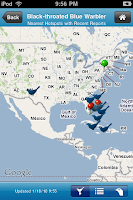Here are the rules:
1) Competition is for the total number of effort-based complete checklists from the United States and Canada submitted from 23-31 Jan 2010.There is also a registration form if you plan to participate. Also, please note that an iPhone or iPod touch is necessary for using BirdsEye and is not included among the prizes.
2) Number of species per checklist does not matter, so the eBirders living in the south don't have any real advantage (other than nicer weather, perhaps).
3) A complete checklist is defined as a checklist submitted that answers 'yes' to the question "are you reporting all species to the best of your ability"?.
4) An effort-based checklist is one using any of our four effort-based protocols: Traveling Count, Stationary Count, Random count, or Area Count.
5) Grand Prizes will go to the three people with the highest number of checklists submitted.
6) The BirdsEye prize will be awarded to the 20 registered individuals with the most checklists submitted.
7) Registration deadline is 31 January 2010.
Lots of eBird checklists from distinct locations are really helpful to eBird, its visualizations, and its utility for science. The more checklists we get, the better!
As I wrote in my original post on BirdsEye, I was one of the app's beta testers throughout the fall. Since then I have done some paid work for them. I have already have a copy of the app, so I will not participate in this particular contest. However I would encourage any birders who have an iPhone or iPod touch to sign up. Both eBird and BirdsEye are already good projects and will get better the more people use them.
A recent update to BirdsEye added eBird data from personal locations as well as public hotspots. This should improve coverage in areas without many eBird hotspots (or eBird users) and make the checklists of recent sightings more complete. Sightings from personal locations are displayed on maps with a different icon (just a bird instead of a bird on a stickpin). They are mapped in the general area of a sighting rather than the exact location where a sighting was entered to avoid the problem of sending unwanted visitors onto private property. (In most cases of true rarities, the sighting will be announced on a state listserv or elsewhere on the internet if visitors are welcome.) You can see an example of this in the image at left.
Another feature that is new or that I simply had not noticed is that BirdsEye picks up data from Central and South America. This works only for the 847 North American species that are included in the app, so you will not find an Andean Condor or Marvelous Spatuletail this way. But if you want to find out where your favorite neotropical migrants are spending the winter, now there is a way using up-to-date observation data. At right is a map of Black-throated Blue Warbler sightings as of January 18th.






